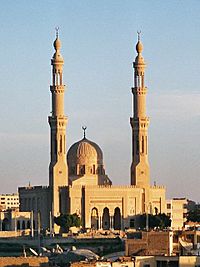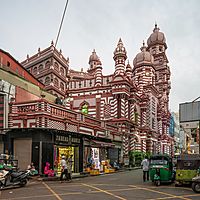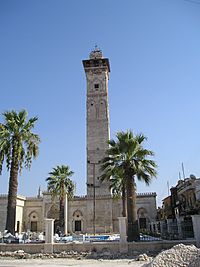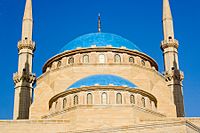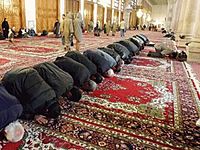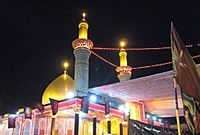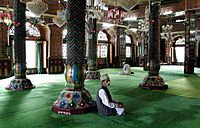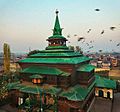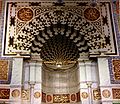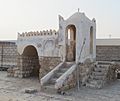Mosque facts for kids
A mosque is a place where Peoples worship. The word mosque comes from the Arabic word masjid. A larger, 'collective', mosque is called a masjid jāmi. Larger mosques offer more services to their community.
For many Muslim people, a mosque is more than a place of worship. Muslims worship, study and discuss Islam, and do many other things in a mosque and its compounds. In the United Kingdom, many mosques are used as community centres. They are also used to teach about Islam. Religious festivals and gatherings are held in mosques. Weddings are one example. Mosques have rules to control what people do inside. One of these is that it is disrespectful to disturb another person who is worshipping.
Many mosques are known for their Islamic architecture. The earliest mosques, opened in 7th century were open-air spaces. They are the Quba Mosque and Masjid al-Nabawi. Later Mosques were buildings that were specially designed. Nowadays, mosques are in every continent, except Antarctica.
Contents
Architecture
Many mosques are famous works of architecture. They are often built in a style that has stayed the same for many centuries. Many mosques have prayer halls, domes, and minarets. They may also have a courtyard. Mosques are often built with patterned walls.
Mosques were first built on the Arabian Peninsula. The Muslims who built them used old architectural styles. They also combined these styles in new ways. A major influence was the palaces built during the Parthian and Sassanid dynasties of Persia. The Sarvestan palace from the Sassanid era is a good example of this. It has an arched entrance and a central dome. These features already existed in Persia before Islam.
After the Arab invasion of Persia, the new style, with its Sassanid influence, was used for the new Islamic world. Many forms of mosques have developed in different regions of the Islamic world. Important mosque types include the early Abbasid mosques, T-type mosques, and the central-dome mosques of Anatolia. In the 20th century, many countries that grew rich from oil paid for the building of many new mosques. The rulers of these countries often hired leading architects to design these mosques. They included non-Muslims.
Arab plan

Many early mosques have a square or rectangular plan. They also have a prayer hall and an enclosed courtyard. This is known as Arab-plan. The first mosques of this type were built during the Umayyad Dynasty.
The flat roof of the prayer hall was supported by columns. Many rows of columns were needed to support such roofs; this is called "hypostyle architecture". One of the most famous hypostyle mosques is the Mezquita de Córdoba in Spain. It is supported by over 850 columns.
In the warm Mediterranean and Middle Eastern climates, the courtyard served to hold the large number of worshippers during Friday prayers. Often, hypostyle mosques have outer arcades. They allow the visitors to enjoy the shade. Arab-plan mosques were built mostly during the Umayyad and Abbasid dynasties. The Arab plan was very simple, which did not allow for much further development. This caused that style of mosque to fall out of favour.
Central dome
The Ottomans began building central dome mosques in the fifteenth century. These mosques have a large dome centered over the prayer hall. There may also be smaller domes, which are off-center over the prayer hall or the rest of the mosque. This style was heavily influenced by the Byzantine religious architecture with its use of central domes.
Iwan
Iwan mosques are famous for their domed rooms and iwans. Iwans are spaces with an arched roof. They have an opening at one end. One or more iwans face a central courtyard that serves as the prayer hall. The style borrows from pre-Islamic Iranian architecture. Most mosques with this style are in Iran.
Parts of Mosques
Minarets
Most mosques have minarets. Minarets are tall towers. Usually they are at one of the corners of the mosque. The top of the minaret is the highest point in the mosque, and usually the highest point in the area around the mosque. The tallest minaret in the world is in the Hassan II Mosque in Casablanca, Morocco.
The first mosques had no minarets. The most conservative Islamic groups, like Wahhabis, still avoid building minarets. They see them as simply a fancy decoration and unnecessary. The first minaret was built in 665 in Basra during the reign of the Umayyad caliph Muawiyah I. Muawiyah encouraged the building of minarets, as they were supposed to be the same as bell towers on Christian churches. Because of this, mosque architects used the shape of the bell tower for their minarets. Both the minaret and the bell tower serve the same purpose — to call the faithful to prayer.
Before the five required daily prayers, a muezzin calls the worshippers to prayer from the minaret. In many countries like Singapore where Muslims are not the majority, mosques are stopped from loudly playing the call to prayer. The main problem is the use of electronic amplification of the call, which is now widely used by mosques.
Domes
The domes were often placed directly above the main prayer hall. They represent the universe that Allah created. At first, these domes were small. They only took up a small part of the roof near the mihrab. Later, they took the whole roof above the prayer hall. Domes normally have the shape of a hemisphere. The Mughals in India popularized onion-shaped domes in South Asia and Persia. Some mosques have several domes, as well as the main large dome. The other domes are often smaller.
Domes would help the imam be heard, as the sound waves would bounce in and then out of the dome making the voice louder.
Prayer hall
All mosques have a prayer hall, which is also called musalla. Normally, there is no furniture in it except for prayer mats or rugs. These are necessary, as Islamic prayer is usually done kneeling.
Some mosques have Arabic calligraphy and Qur'anic verses on the walls to help worshipers focus on the beauty of Islam and its holiest book, the Qur'an, as well as for decoration.
The qiblah wall is usually at the other side of the entrance to the prayer hall. This wall is specially decorated. In a properly sited mosque, it will be set perpendicular to a line leading to Mecca. People pray in rows parallel to the qiblah wall. They arrange themselves so they face Mecca. In the qiblah wall, usually at its center, is the mihrab, a niche or depression showing the direction of Mecca. The mihrab serves as the place where the imam leads the five daily prayers.

Washing (wudhu)
All people must wash themselves before they pray. Mosques often have fountains or other facilities for washing in their entrances or courtyards, so that people can perform the washing ritual before prayer. At very small mosques, worshippers may use restrooms for their ritual washing, or wu'du. In traditional mosques, there is often a building specially for washing. This is often in the center of the courtyard. In the prayer halls, people must not wear shoes for much the same reason.
Modern features
Modern mosques should appeal to the community they serve. For this reason, other facilities may also be available at the mosque, like health clinics, libraries, and sports halls.
The inside of mosques
-
Inside the Shah Faisal Mosque in Islamabad, Pakistan
-
Inside the Sulayman Pasha Mosque in Cairo, Egypt
-
The Nasr ol Molk Mosque in Shiraz, Iran
There may be decorative tiles, plaster or coloured mosaics on the walls. There are no pictures or statues.
Religious functions
Prayers
Adult Muslims are expected to pray five times a day. Most mosques have formal prayers for each of these times. If performing the prayer is difficult, for example for ill people, then exceptions are made.
Mosques also hold a special prayer service, called jumuah. This is done once a week. It is a form of Sabbath and replaces the Friday prayers at the mosque. Daily prayers can be done anywhere. However, Muslims are expected to do their Friday prayer at the mosque.
When a Muslim dies, a funeral prayer is normally held. It is held outdoors in a courtyard or square close to the mosque. The prayers have all the worshippers present, including the imam, taking part. During eclipses, mosques will host special prayers called eclipse prayers.
There are two large holidays (Eids) in the Islamic calendar. During these days, there are special prayers at mosques in the morning. Larger mosques will normally hold them for their own communities as well as the people from smaller local mosques. Mosques, especially those in countries where Muslims are the majority, will also host Eid prayers outside in courtyards or town squares.

Ramadan events
There are many events in Ramadan, Islam's holiest month. During Ramadan, Muslims must fast during the day. Mosques organise iftar dinners after sunset. These are done after the fourth required prayer of the day. Part of the food is given by members of the community, which creates nightly potluck dinners. The community contribution to these dinners is required. For this reason, mosques with smaller communities may not be able to hold the iftar dinners daily.
Some mosques will also hold meals in the morning before dawn. Mosques will often invite poorer members of the community to these meals. Islam sees giving charity during Ramadan as good acts.
Larger mosques sometimes offer special, optional prayers. They are done after the last required prayer of the day. During each night of prayers, one member of the community who has memorized the entire Qur’an will recite a part of the book. It can last for up to two hours. Sometimes, several such people (not necessarily of the local community) take turns to do this. During the last ten days of Ramadan, larger mosques will host all-night programs to observe Laylat al-Qadr. It is the night Muslims believe that the Islamic prophet Muhammad first received Qur'anic revelations. On that night, between sunset and sunrise, mosques employ speakers to teach the worshipers about Islam. Mosques or the community usually provide meals at times through the night.
Political functions
During the late twentieth century, more and more mosques have been used for political purposes. Modern-day mosques in the Western world want to educate good citizens. The details differ greatly from mosque to mosque and from country to country.
Advocacy
Countries with small Muslim populations use mosques as a way to support civic participation. They are more likely to do this than Muslim-majority countries of the Greater Middle East. American mosques host voter registration and civic participation drives. In the United States, Muslims are often immigrants, or the children of immigrants. Mosques want to interest these people for politics. They also want to keep them informed about issues that concern the Muslim community. People who attend the services at the mosque regularly are more likely to take part in protests, to sign petitions, and to involve themselves in political matters.
Social conflict
Like other places of worship, mosques can be at the center of social conflicts.
After the September 11 attacks, several American mosques were targets of attacks. These ranged from simple vandalism to arson.
The Jewish Defense League was suspected of plotting to bomb the King Fahd Mosque in Culver City, California. There were similar attacks in the United Kingdom after the 7 July 2005 London bombings. Outside the Western world, in June 2001, the Hassan Bek Mosque was the target of attacks. The attacks involved hundreds of Israelis angry at Arabs for a previous attack.
Saudi influence
Saudi involvement in building mosques around the world only goes back to the 1960s. In the 1980s, the Saudi Arabian government began to pay for the building of mosques in countries around the world. An estimated US$45 billion has been spent by the Saudi Arabian government for mosques and Islamic schools in foreign countries. Ain al-Yaqeen, a Saudi newspaper, reported in 2002 that Saudi money may have helped to build as many as 1,500 mosques and 2,000 other Islamic centers. Saudi citizens have also given a lot of money to mosques in the Islamic world, especially in countries where they see Muslims as poor and oppressed. Following the fall of the Soviet Union, in 1992, mosques in Afghanistan received money from Saudi citizens. The King Fahd Mosque in Culver City, California and the Islamic Cultural Center of Italy in Rome are two of Saudi Arabia's largest investments in foreign mosques as former Saudi king Fahd bin Abdul Aziz al-Saud gave US$8 million and US$50 million to the two mosques, respectively.
Rules and behaviour in mosques
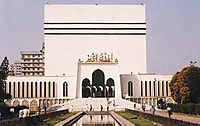
In a mosque, people should keep focused on worshiping Allah. For this reason, there are a number of rules about the correct behaviour in a mosque. Some of these rules are the same all over the world, such as no shoes should be worn in the prayer hall. Other rules are different from mosque to mosque.
Prayer leader
It is generally seen as good to have someone who leads the prayers, though this is not strictly necessary. The person who usually leads the prayers is called imam. He must be a free and honest man. He should also be an authority when it comes to answering questions on religion. In mosques that were built or that are kept up by the government, the imam is selected by the ruler. In private mosques, the community selects the imam, through majority voting.
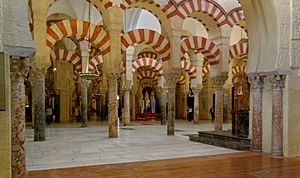
Only men may lead prayers for men. Women are allowed to lead prayers for congregations where there are only women.
Attending a mosque
In addition to washing, there are other rules that also apply to those who enter the mosque, even if they do not wish to pray there. It is forbidden to wear shoes in the carpeted area of the prayer hall. Some mosques also do not allow wearing shoes in other parts, even though these may not be devoted to praying.
Islam requires that its believers wear clothes that show modesty. As a result, both men and women must follow this rule when they attend a mosque (though mosques may not always enforce the rules). Men are supposed to come to the mosque wearing loose and clean clothes that do not show the shape of the body. Similarly, women who come to the mosque are expected to wear loose clothing, shirts, pants that cover to the wrists and ankles and cover their heads such as with a hijab. Many Muslims, regardless of their ethnic background, wear Middle eastern clothing associated with Arabic Islam to special occasions and prayers at mosques.
Mosques are places of worship. For this reason, those inside the mosque should be respectful to those who are praying. Loud talking or discussion of topics that could be disrespectful, is forbidden in areas where people are praying. It is also considered as rude to walk in front of Muslims in prayer or otherwise disturb them.
Men and women pray in different parts
Islamic law requires men and women to be separated in the prayer hall. Ideally, women should pray behind men. The second caliph Umar at one time stopped women from attending mosques, especially at night, because he feared they may be teased by males, so he made them to pray at home. Sometimes a special part of the mosque was railed off for women; for example, the governor of Mecca in 870 had ropes tied between the columns to make a separate place for women.
Many mosques today will put the women behind a barrier or partition or in another room. Mosques in South and Southeast Asia put men and women in separate rooms, as the divisions were built into them centuries ago. In nearly two-thirds of American mosques, women pray behind partitions or in separate areas, not in the main prayer hall; some mosques do not admit women at all. Although there are sections only for women and children, the Grand Mosque in Mecca is desegregated.
Non-Muslims in mosques
A few scholars of Islamic law believe that non-Muslims may be allowed into mosques, as long as they do not sleep or eat there. Followers of the Maliki school of Islamic jurisprudence disagree. They say that non-Muslims may not be allowed into mosques at all.
Different countries have different opinions on the question. Nearly all the mosques in the Arabian Peninsula as well as Morocco do not allow non-Muslims. The Hassan II Mosque in Casablanca is one of only two mosques in Morocco currently open to non-Muslims.
In modern-day Saudi Arabia, the Grand Mosque and all of Mecca are open only to Muslims. Likewise, the Masjid al-Nabawi and the city of Medina that surrounds it are also off-limits to those who do not practice Islam. For mosques in other areas, it has most commonly been taken that non-Muslims may only enter mosques if granted permission to do so by Muslims and if they have a proper reason.
In modern Turkey non-Muslim tourists are allowed to enter any mosque, but must obey the rules of decorum. Visiting a mosque is allowed only between prayers; visitors must wear long trousers and take off their shoes; women must cover their heads; no photos; no loud talk is allowed. No references to other religions are allowed (no crosses on necklaces, no cross gestures etc.).
However, there are also many other places in the west as well as the Islamic world where non-Muslims are welcome to enter mosques. Most mosques in the United States, for example, report receiving non-Muslim visitors every month. Many Mosques throughout the United States welcome non-Muslims as a sign of openness to the rest of the community and to encourage conversions to Islam.
Dogs
Dogs are usually banned from entering mosques, but on 24 September 2008, the Muslim Law Council UK made special ruling, called a fatwa, which granted a blind Muslim permission to take his guide dog into the mosque.
Mosques as hostels
It is common for a smaller mosque to serve as a hostel for Muslims on haj (pilgrimage to Mecca). Sometimes mosques are used for refugees, or as temporary homes for homeless people. Obligations to neighbours in Islam are very strict, and specific. In the Qur'an Mohammed(pbuh) said that a person who helps others in the hour of need, and who helps the oppressed; that person God will help on the Day of Travail (agony). There are other commands, such as helping the poor and being nice to people. An important part of being Muslim, or just being part of the mosque, is taking care of people who need help. A mosque is a social, as well as a religious, group.
A madrassa is a little different from a mosque. A madrassa focuses on teaching Islam, usually to children and young people.
Mosques in Spain
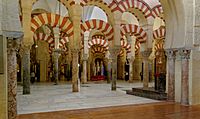
When Spain was under Muslim control, some of the most beautiful buildings were mosques. After 1491, Spain was under Christian control. However, the Christians did not tear down the mosques. They simply put a crucifix in them to make them into churches. These mosques influenced the Renaissance architecture (way of building) in Europe.
Images for kids
-
The Blue Mosque in Istanbul, Turkey.
-
Namazgah Mosque in 2018, once completed it will be the largest mosque in the Balkans.
-
Faisal Mosque in Islamabad is the largest mosque in Pakistan and in South Asia with a capacity of 300,000
-
The Hagia Sophia in Istanbul, Turkey, was converted into a mosque after the Ottoman conquest of Constantinople in 1453
-
Iftar at Taipei Grand Mosque, Taiwan during Ramadan
-
Vault ceiling of the Nasir al-Mulk Mosque in Shiraz, Iran
-
Adina Mosque, once the largest mosque in South Asia, in Pandua, the first capital of the Bengal Sultanate.
-
Huseina Čauša džamija (a.k.a. Džindijska), 17th century traditional wooden mosque in Tuzla, Bosnia and Herzegovina
-
Mihrab in Al-Masjid an-Nabawi, Medina, Saudi Arabia
-
The oldest standing minaret in the world at the Great Mosque of Kairouan, Tunisia
-
The 201 Dome Mosque in Tangail District, Bangladesh.
-
Evening praying at the Lahti Mosque in Lahti, Finland
-
President George W. Bush inside the Islamic Center of Washington D.C., US
-
The East London Mosque was one of the first in Britain to be allowed to use loudspeakers to broadcast the adhan
-
2010 Aerial view of the largest mosque in the world, The Sacred Mosque (Al-Masjid Al-Ḥarām) of Mecca in the Hejaz region of Saudi Arabia, with the Kaaba in the center
-
Islam's second holiest site Al-Masjid an-Nabawi (The Prophet's Mosque) in Medina
-
Umayyad Mosque built by the Umayyad Caliphate
-
The Mosque of the Companions (Masjid As-Sahabah) in Massawa, Eritrea, Horn of Africa
-
Masjid al-Qiblatayn (Mosque of the two Qiblahs) in Medina
-
The hypostyle prayer hall in the Great Mosque of Kairouan, Tunisia
-
A wooden prayer hall of the Järvenpää Mosque in Järvenpää, Finland
-
Kursu in Čaršija mosque in Zenica, Bosnia and Herzegovina
-
Ulu mosque in Utrecht, Netherlands
See also
 In Spanish: Mezquita para niños
In Spanish: Mezquita para niños


